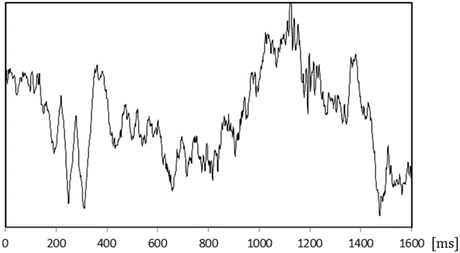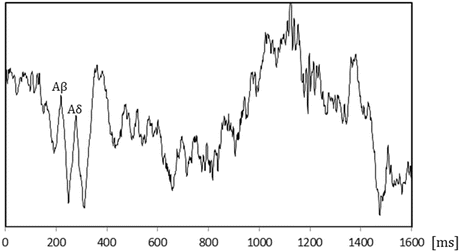Abstract
No one can deny that pain serves as an alarm. Sometimes pain informs us about severe abnormalities inside our body. However, pain (in particular, chronic pain) does not always have the role of an alarm. Pain itself can be harmful, as in the case of patients with chronic pain. Thus, we should reveal the mechanisms of pain and control it even though this is a challenging task. Pain is always subjective to individuals, and we have no definitive and objective evaluation methods for measuring pain. Indeed, pain is very complex and difficult to understand. In this chapter, in order to better understand the complex phenomenon of pain, I first discuss the definitions and classifications of pain. Second, I explain methods for evaluating pain, including the methods of potential objective evaluation. Lastly, I describe the relationship between pain and the central nervous system, especially with respect to cognitive function, emotion, and psychiatric illness. I expect that there will be a paradigm shift in pain treatment in the future; studies of the affective components of pain will greatly progress, and drug discovery research will specifically aim at reducing pain.
Access this chapter
Tax calculation will be finalised at checkout
Purchases are for personal use only
References
Abram, S.E., Haddox, J.D.: The Pain Clinic Manual, 2nd edn. Lippincott, Williams, and Wilkins, Philadelphia (2000)
Asmundson, G.J., Katz, J.: Understanding the co-occurrence of anxiety disorders and chronic pain: state-of-the-art. Depress. Anxiety. 26, 888–901 (2009)
Bantick, S.J., Wise, R.G., Ploghaus, A., Clare, S., Smith, S.M., Tracey, I.: Imaging how attention modulates pain in humans using functional MRI. Brain 125, 310–319 (2002)
Baranauskas, G., Nistri, A.: Sensitization of pain pathways in the spinal cord: cellular mechanisms. Prog. Neurobiol. 54, 349–365 (1998)
Barlow, D.H.: Clinical Handbook of Psychological Disorders: A Step-by-Step Treatment Manual, 3rd edn. The Guilford Press, New York (2001)
Beecher, H.K.: Pain in men wounded in battle. Ann. Surg. 123, 96–105 (1946)
Besson, J.M., Chaouch, A.: Peripheral and spinal mechanisms of nociception. Physiol. Rev. 67, 67–186 (1987)
Bonica, J.J.: Neurophysiologic and pathologic aspects of acute and chronic pain. Arch. Surg. 112, 750–761 (1977)
Bruehl, S., Burns, J.W., Chung, O.Y., Chont, M.: Pain-related effects of trait anger expression: neural substrates and the role of endogenous opioid mechanisms. Neurosci. Biobehav. Rev. 33, 475–491 (2009)
Chou, R., Shekelle, P.: Will this patient develop persistent disabling low back pain? JAMA 303, 1295–1302 (2010)
de la Fuente-Sandoval, C., Favila, R., Gomez-Martin, D., Pellicer, F., Graff-Guerrero, A.: Functional magnetic resonance imaging response to experimental pain in drug-free patients with schizophrenia. Psychiatry Res. 183, 99–104 (2010)
Defrin, R., Ginzburg, K., Solomon, Z., et al.: Quantitative testing of pain perception in subjects with PTSD – implications for the mechanism of the coexistence between PTSD and chronic pain. Pain 138, 450–459 (2008)
Dworkin, R.H., Turk, D.C., Revicki, D.A., Harding, G., Coyne, K.S., Peirce-Sandner, S., Bhagwat, D., Everton, D., Burke, L.B., Cowan, P., Farrar, J.T., Hertz, S., Max, M.B., Rappaport, B.A., Melzack, R.: Development and initial validation of an expanded and revised version of the Short-form McGill Pain Questionnaire (SF-MPQ-2). Pain 144, 35–42 (2009)
Florin, I., Franzen, U., Meier, M., Schneider, S.: Pressure sensitivity in bulimic women; a contribution to research in body image distortion. J. Psychosom. Res. 32, 439–444 (1988)
Fone, K.C., Porkess, M.V.: Behavioural and neurochemical effects of post-weaning social isolation in rodents-relevance to developmental neuropsychiatric disorders. Neurosci. Biobehav. Rev. 32, 1087–1102 (2008)
Franek, M., Vaculin, S., Yamamotova, A., Stastny, F., Bubenikova-Valesova, V., Rokyta, R.: Pain perception in neurodevelopmental animal models of schizophrenia. Physiol. Res. 59, 811–819 (2010)
Hinrichs-Rocker, A., Schultz, K., Jarvinen, I., Lefering, R., Simanski, C., Neugebauer, E.A.: Psychosocial predictors and correlates for chronic post-surgical pain (CPSP) – a systematic review. Eur. J. Pain 13, 719–730 (2009)
Hirofumi, M., Yuji, S.: Assessment of cognitive aspect of pain: development, reliability, and validation of Japanese version of pain catastrophizing scale. Jpn. J. Psychosom. Med. 47, 95–102 (2007)
Jeon, D., Kim, S., Chetana, M., et al.: Observational fear learning involves affective pain system and Cav1.2 Ca2+ channels in ACC. Nat. Neurosci. 13, 482–488 (2010)
Klossika, I., Flor, H., Kamping, S., et al.: Emotional modulation of pain: a clinical perspective. Pain 124, 264–268 (2006)
Kraus, A., Geuze, E., Schmahl, C., et al.: Differentiation of pain ratings in combat-related posttraumatic stress disorder. Pain 143, 179–185 (2009)
Kundermann, B., Hemmeter-Spernal, J., Strate, P., et al.: Pain sensitivity in major depression and its relationship to central serotoninergic function as reflected by the neuroendocrine response to clomipramine. J. Psychiatr. Res. 43, 1253–1261 (2009)
Lautenbacher, S., Huber, C., Schofer, D., et al.: Attentional and emotional mechanisms related to pain as predictors of chronic postoperative pain: a comparison with other psychological and physiological predictors. Pain 151, 722–731 (2010)
Leeuw, M., Goossens, M.E., Linton, S.J., Crombez, G., Boersma, K., Vlaeyen, J.W.: The fear-avoidance model of musculoskeletal pain: current state of scientific evidence. J. Behav. Med. 30, 77–94 (2007)
Loeser, J.D.: Perspectives on pain. In: Padgham, C., Hedges, A., Turner, P. (eds.) Clinical Pharmacology and Therapeutics, p. 314. University Press, Baltimore (1980)
Loeser, J.D.: Pain and suffering. Clin. J. Pain 16, S2–S6 (2000)
Melzack, R.: The short-form McGill pain questionnaire. Pain 30, 191–197 (1987)
Melzack, R., Torgerson, W.S.: On the language of pain. Anesthesiology 34, 50–59 (1971)
Munro, G., Erichsen, H.K., Mirza, N.R.: Pharamacological comparison of anticonvulsant drugs in animal models of persistent pain and anxiety. Neuropharmacology 53, 609–618 (2007)
Murakami, H., Tamasawa, N., Yamashita, M., et al.: Altered pain perception in schizophrenia. Lancet 375, 864 (2010)
Nakae, A., Endo, K., Adachi, T., Ikeda, T., Hagihira, S., Mashimo, T., et al.: The influence of working memory capacity on experimental heat pain. J. Pain 14(10), 1088–1096 (2013)
Narita, M., Kaneko, C., Miyoshi, K., et al.: Chronic pain induces anxiety with concomitant changes in opioidergic function in the amygdala. Neuropsychopharamacology 31, 739–750 (2006)
Olausson, H., Lamarre, Y., Backlund, H., Morin, C., Wallin, B.G., Starck, G., et al.: Unmyelinated tactile afferents signal touch and project to insular cortex. Nat. Neurosci. 5, 900–904 (2002)
Osman, A., Barrios, F.X., Kopper, B.A., Hauptmann, W., Jones, J., O’Neill, E.: Factor structure, reliability, and validity of the pain catastrophizing scale. J. Behav. Med. 20, 589–605 (1997)
Park, S.H., Sonty, N.: Positive affect mediates the relationship between pain-related coping efficacy and interference in social functioning. J. Pain 11, 1267–1273 (2010)
Potvin, S., Marchand, S.: Hypoalgesia in schizophrenia is independent of antipsychotic drugs: a systematic quantitative review of experimental studies. Pain 138, 70–78 (2008)
Rachman, S., Hodgson, R.: I. Synchrony and desynchrony in fear and avoidance. Behav. Res. Ther. 12, 311–318 (1974)
Rhudy, J.L., Meagher, M.W.: Fear and anxiety: divergent effects on human pain thresholds. Pain 84, 65–75 (2000)
Rhudy, J.L., Bartley, E.J., Williams, A.E.: Habituation, sensitization, and emotional valence modulation of pain responses. Pain 148, 320–327 (2010)
Ringkamp, M., Meyer, R.A.: Physiology of nociceptors. In: Basbaum, A.I., Bushnell, C. (eds.) Science of Pain, pp. 105–107. Amsterdam, Elsevier (2008)
Schacter, D.L., Gilbert, D.T., Wegner, D.M.: Psychology, p. 310. Worth Publishers, New York (2011)
Schmahl, C., Greffrath, W., Baumgartner, U., et al.: Differential nociceptive deficits in patients with borderline personality disorder and self-injurious behavior: laser-evoked potentials, spatial discrimination of noxious stimuli, and pain ratings. Pain 110, 470–479 (2004)
Stander, S., Steinhoff, M., Schmelz, M., Weisshaar, E., Metze, D., Luger, T.: Neurophysiology of pruritus: cutaneous elicitation of itch. Arch. Dermatol. 139, 1463–1470 (2003)
Sullivan, M.J.L., Bishop, S.R., Pivik, J.: The pain catastrophizing scale: development and validation. Psychol. Assess. 7, 524–532 (1995)
Suzuki, T., Amata, M., Sakaue, G., et al.: Experimental neuropathy in mice is associated with delayed behavioral changes related to anxiety and depression. Anesth. Analg. 104, 1570–1577 (2007)
Treede, R.D., Meyer, R.A., Campbell, J.N.: Myelinated mechanically insensitive afferents from monkey hairy skin: heat-response properties. J. Neurophysiol. 80, 1082–1093 (1998)
Turk, D.C., Audette, J., Levy, R.M., Mackey, S.C., Stanos, S.: Assessment and treatment of psychosocial comorbidities in patients with neuropathic pain. Mayo Clin. Proc. 85, S42–S50 (2010)
Villemure, C., Bushnell, M.C.: Mood influences supraspinal pain processing separately from attention. J. Neurosci. 29, 705–715 (2009)
Wylle, K.P., Tregellas, J.R.: The role of the insula in schizophrenia. Schizophr. Res. 123, 93–104 (2010)
Yoshino, A., Okamoto, Y., Onoda, K., et al.: Sadness enhances the experience of pain via neural activation in the anterior cingulate cortex and amygdala: an fMRI study. NeuroImage 50, 1194–1201 (2010)
Zigmond, A.S., Snaith, R.P.: The hospital anxiety and depression scale. Acta Psychiatr. Scand. 67, 361–370 (1983)
Author information
Authors and Affiliations
Corresponding author
Editor information
Editors and Affiliations
Exercises
Exercises
-
1.
The figures below show the waveforms of evoked potentials .
What are the latency and amplitude of each evoked potential?
What fibers are stimulated?


-
2.
State the correlation between pain perception and cognitive impairment.
-
3.
State the correlation between emotion and pain perception.
-
4.
What do you think about the next generation of analgesics?
Rights and permissions
Copyright information
© 2016 Springer Japan
About this chapter
Cite this chapter
Nakae, A. (2016). Mechanisms of Pain. In: Kasaki, M., Ishiguro, H., Asada, M., Osaka, M., Fujikado, T. (eds) Cognitive Neuroscience Robotics B. Springer, Tokyo. https://doi.org/10.1007/978-4-431-54598-9_6
Download citation
DOI: https://doi.org/10.1007/978-4-431-54598-9_6
Publisher Name: Springer, Tokyo
Print ISBN: 978-4-431-54597-2
Online ISBN: 978-4-431-54598-9
eBook Packages: EngineeringEngineering (R0)



